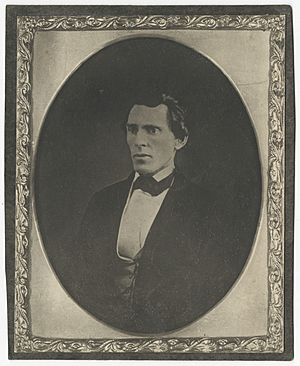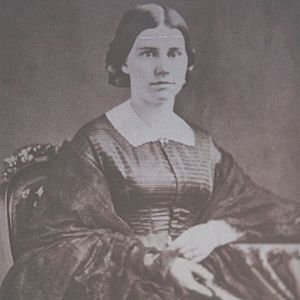John W. North facts for kids
Quick facts for kids
John Wesley North
|
|
|---|---|
 |
|
| Minnesota Territorial House of Representatives | |
| In office 1849–1851 |
|
| Nevada Territorial Supreme Court | |
| In office 1863–1864 |
|
| Personal details | |
| Born | January 4, 1815 Sand Lake, Rensselaer County, New York |
| Died | February 22, 1890 Fresno, California |
| Resting place | Evergreen Cemetery (Riverside, California) |
| Political party | Republican |
| Spouse | Emma Bacon (d. 1847). Ann Hendrix Loomis (1848–1890) |
| Children | 6 |
| Occupation | Attorney |
John Wesley North (January 4, 1815 – February 22, 1890) was an important American abolitionist, lawyer, and politician. An abolitionist was someone who worked to end slavery.
He helped start the Republican Party in Minnesota. North also served in special meetings called constitutional conventions in both Minnesota and Nevada. He helped create the rules for these states.
As a lawmaker in the Minnesota Territorial Legislature, North played a big part in starting the University of Minnesota. Later, he became Nevada's first surveyor general. This job involved mapping and measuring land. He also served as a judge on Nevada's highest court.
John Wesley North is also famous for founding two cities: Northfield, Minnesota and Riverside, California.
Contents
Early Life and Political Start
John North was born on January 4, 1815, in New York. His family was very involved with the Methodist Church. This religious background shaped his strong beliefs.
He met Gerrit Smith, a rich leader of the abolitionist movement. Smith greatly influenced North's decision to fight against slavery.
In 1838, North went to Wesleyan University. He became known for his strong anti-slavery views. He even lectured for the Connecticut Anti-Slavery Society.
North later became a lawyer. He connected with other anti-slavery lawyers and educators. His friendship with the poet John Greenleaf Whittier was very important to him.
In 1849, North moved to the Minnesota Territory. He continued his law practice there. He was elected to the Minnesota Territorial Legislature in 1850.
North helped found the Republican Party of Minnesota in 1855. In 1857, he was part of Minnesota's state Constitutional Convention. This group wrote the state's constitution.
In 1860, he was a delegate to the Republican Convention. This is where Abraham Lincoln was chosen to run for president. North was even on the committee that told Lincoln he was nominated.
Besides his work as a lawmaker, North helped create the University of Minnesota. He wrote the law that officially started the university. He also managed its money as treasurer from 1851 to 1860.
Family Life
John North married Emma Bacon in 1845. Sadly, she passed away in 1847.
In 1848, North married Ann Hendrix Loomis. Ann's father, Dr. George Loomis, was also an abolitionist. He cared for North when he was very sick.
John and Ann North had eight children together. Six of their children grew up to be adults.
Founding Northfield, Minnesota
On August 17, 1855, John North bought land in Minnesota. He planned to build a new town there. The town was officially named Northfield, Minnesota.
In the summer of 1855, North started building a sawmill. This mill helped cut lumber for new buildings. It began working by December of that year.
North's wife, Ann Loomis North, and their three young children joined him in Northfield in January 1856. They later had a fourth child, John Greenleaf North, born in October 1856. The North family eventually had six children.
The Norths helped start many early groups in Northfield. John was very interested in education. He helped form the Lyceum Society in 1856 and was its first president.
North faced financial difficulties in 1857. His friend, Charles Augustus Wheaton, bought his business interests in 1859. Wheaton had moved to Northfield on the Norths' advice.
John North's direct connection to Northfield lasted about six years. He left before the famous attempt by the James–Younger Gang to rob the First National Bank of Northfield in 1876.
Nevada Judge and Challenges
In 1861, President Abraham Lincoln appointed North as the official surveyor for the new Territory of Nevada. North moved to Virginia City, Nevada. This was an important job because Nevada was a mining area. Surveyors helped decide the boundaries of mining claims, which often led to lawsuits.
Lincoln likely wanted North to help keep Nevada loyal to the Union. He also hoped North would help Nevada become a Republican state. North surveyed land, invested in silver mining, and practiced law.
In 1863, Lincoln gave North a temporary appointment to Nevada's highest court. This court was the start of the United States District Court for the District of Nevada. North was praised for his decisions and for clearing up old cases.
He was also elected president of the 1863 constitutional convention in Carson City. This group worked to write a state constitution for Nevada. In both his roles, North had disagreements with William M. Stewart. Stewart was a powerful lawyer who represented large mining companies.
North's rulings often supported smaller mining companies. This went against the interests of Stewart's larger clients. Stewart made accusations against North. North denied these claims. Stewart later had to publicly take back his words. However, Stewart continued to attack North in newspapers.
North resigned from his judge position due to health issues after less than a year. He then sued Stewart for his false statements. An independent court looked at both sides. It decided that Stewart had indeed slandered North. The court also found no proof that North had done anything wrong.
Despite winning the case, North left Nevada for California. Stewart stayed and became a U.S. Senator for the new state of Nevada.
Founding Riverside, California
North and his family moved to Santa Clara, California. They then lived in Tennessee for a short time. Because of his strong anti-slavery beliefs, North faced challenges in Tennessee. He moved back to California in 1870.
In 1870, North helped found the city of Riverside, California. Some of his friends from Minnesota joined him there.
In 1879, he and his family moved to San Francisco. He joined a law firm there. That year, he was nominated for the California Supreme Court, but he did not win.
In 1880, he became an agent for a farming project near Fresno, California. He opened a law office in Fresno. He also built a house and started a farm in a small community called Oleander, California. His wife did not move with him this time.
John North passed away in Fresno on February 22, 1890. He was buried in Riverside's Evergreen Cemetery.
Today, John W. North High School and the John W. North Water Treatment Plant in Riverside are named after him.
Images for kids



